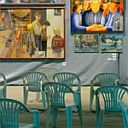0249 Terrified by the Close Other. Is the Postwar History of German Art Ready to Embrace "State Functionaries"?
Identifiers (Article)
Identifiers (Files)
Abstract
The article sets out to investigate the fundamental problem for the methodology of postwar German art history, namely, the unavoidable fusion of two markedly different perspectives, i.e., those of East and West Germany, into a coherent narrative. The reconstruction of key exhibitions and controversies sparked by East German art, in 1989 and beyond, suggests that the revision of the canon of art history may be faced with greater challenges whenever adopting the perspective of the close Other (political or ideological), rather than that of a remote Other (ethnic or cultural). The incorporation of the close Other into a uniform narrative on art history can be a moot point, most notably in those cases where the western concept of art calls for a necessary restatement, and one's identity needs to be critically redefined in the process. This is best exemplified by what happened in Germany after 1989.
Statistics


License

This work is licensed under a Creative Commons Attribution-NonCommercial-NoDerivatives 4.0 International License.



